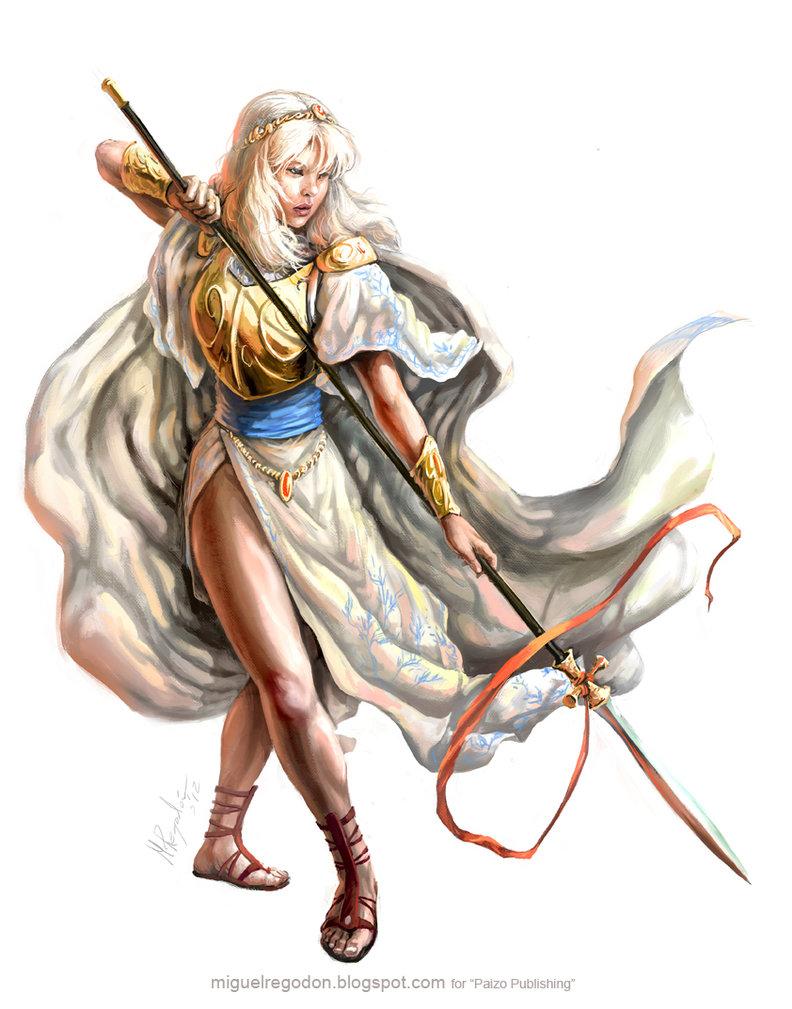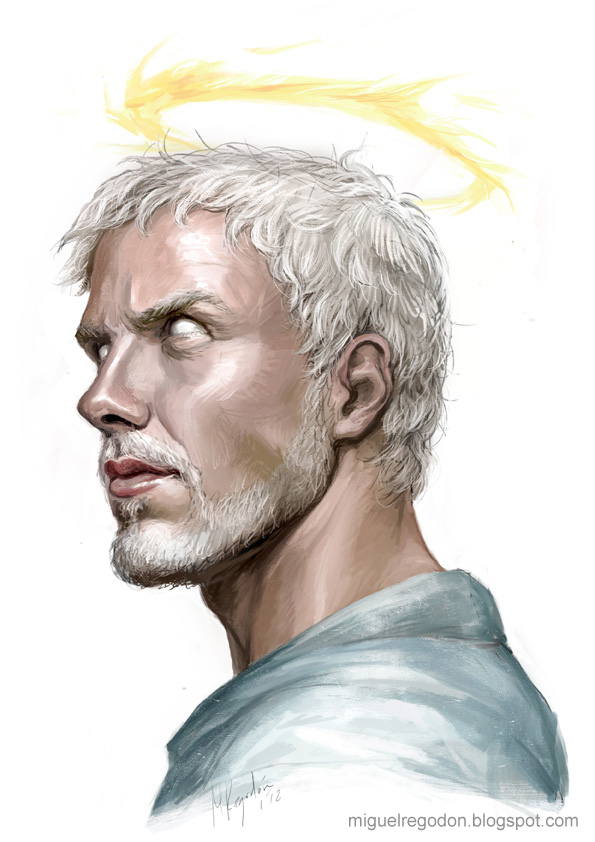
Beautiful artwork by Ameera, @mikandii on Twitter.
(Did I have some inspiration when making my druid? Perhaps. In my defense, I have red to rose-gold hair and very pale skin, so this is not just a reflection of Keyleth, but of myself as well.)
Stumbling out of the trees, pack slung on her back, the red-headed wood elf blinked in the midday sun. She had come upon a trail she had been told went to Westfield, the nearest town, and her first stop on what would be a very long journey. After walking in silence for the better part of an hour, her ears caught the sound of singing in the near distance.
At length, a band of dwarves appeared, singing and laughing joyfully. The elf had only met a small handful of dwarves in her twenty-eight years, sheltered as she had been growing up in her small woodland village.
“Ho, friend!” one of them declared, stopping in his tracks. He peered at the obviously distraught elf. “What’s the matter? Why do you travel alone on this fine day?”
She bit her lip and shook her head.
“Ah. Well, where are you headed?”
“Westfield,” she squeaked.
“We’ve just come from Westfield. You don’t want to go there. Not much interesting happening,” another remarked. “We’re headed to Corona.”
“Won’t you join us?” the first dwarf asked, and the other four nodded in agreement.
She agreed, and they made way to Corona, which the dwarves promised was much larger than Westfield. They were adventurers in search of treasure, and were looking to unload several rare human artifacts which, while interesting, were not as interesting to them as the gold they could get in exchange. They believed they would get the best prices in the black markets of Corona.
Adrik, Darrak, Gardain, Rangrim and Tordek entertained their new, nameless elf friend with tales of their daring, dangerous escapades, and at length she was laughing along with them, enraptured with their stories.
Sensing her mood had lifted, Adrik cleared his throat. “So what brings you out to the world?”
Her face was somber and she told her tragic tale. She told how a mysterious plague had struck her village. The greatest healers in the land had been summoned, and even they were baffled at the sickness. Every elf was afflicted… all except her, but no one knew why. While others succumbed to their illness, she remained, and as their numbers dwindled and the last few became sick, the elders had summoned her. She was told that as the last of the Moonwalkers, she should leave this place of despair, and seek out a new life with a new clan. She tearfully bid farewell to her people, certain they would never meet again, and had set out through hidden woodland paths to their closest neighbors, which weren’t very close at all, when she stopped.
“I was forced to leave my home, but then I was given a choice. If I went to another elf clan, I would integrate into their society. I had grown up with a deep love of nature. There was never any question I would be a druid. I would go and join their ranks of druids and care for their groves and creatures, and the name Moonwalker would soon be lost. Or—I could go into the world. Make a name for myself, and keep our name and traditions alive through me. And maybe I could find a new clan, one of my choosing. Besides,” she continued, tossing her long hair back, “even for elves, I’ve seen firsthand that life is too short. Shouldn’t we want to experience it all?”
“I’ll drink to that!” Darrak exclaimed.
“And I will, as soon as we get to Corona,” Rangrim quipped.
About an hour after nightfall, and several rousing choruses of “Intro the Dragon’s Lair” later, they did arrive in Corona. Though it was dark out, the city was alive, and the young elf marveled at the variety of life she saw all around. Markets were beginning to close, but there were still carts and stalls selling their wares, and so many spilled out of taverns. She had never before seen so many humans, elves, dwarves, gnomes, and everyone in between all together in one place. The air hummed with activity, conversation, bartering, song, laughter. The dwarves steered her towards one tavern in particular, The Tipsy Goat.
There they learned more about their elf companion. She was born and raised in Arrowan, to her mother, Ilenia, and her father, Carric (who was one of the few of her clan left alive, at the time of her departure), an elder and one-time ranger. Druidry came naturally to her—from a young age, she followed the village druids on their daily tasks and spied on them at every opportunity. She truly became a druid in her own right when she helped expel a shambling band of undead and their puppet master from a nearby human settlement. From then on a member of the Emerald Enclave, she belonged to the Circle of the Moon, and helped keep balance in the natural world, even sometimes bringing an end to those who would threaten it.
It became evident over time that she would follow in her father’s footsteps and become a leader of her people. Her moral code was simple, and one best described by a certain community of humans—if it harms none, do as you will. But she took it very seriously. Nature had always been her religion and her first love, and she honored it by caring for every creature, and she always firmly believed in helping those who could not help themselves. She was just as likely to jump to defend people’s freedom as she was to protect the innocent.
As she had such a deep connection to nature, it was no wonder she identified so closely with the elven god Rillifane Rallathil, god of the woodland and the wild places, the father of wood elves and protector of druids. Though ever since she was a young girl, she had a fascination with the unicorn goddess Lurue, and held her in her heart. But as a druid, she revered all the gods of the first circle, those deities closest to the power and majesty of the natural world, including Chantea, Eldath, Mielikki, Silvanus, and even more.
The band of dwarves introduced her to her first drink of Dwarvish ale, which over time, she would grow to have quite a fondness for. As she had brought a tidy sum of money with her, she paid for lodging for quite some time, and over the next week explored the city with her new friends. She accompanied them to meet shady characters to pawn their artifacts. They took her to eat at many varied establishments, and she tried to be kind to their less elegant Dwarvish fare, but discovered she had a real love of the many varieties of cheeses that humans in particular had come up with. She tried every food that came her way, and every drink, save for one rum that Rangrim snatched from her hands, promising that her headache the next day would not be worth the amber liquid. While Elvish berrywine reminded her of home, Dwarvish ale and human-made fizzy concoctions were her favorite. Her affinity and bond with animals only grew stronger—when she grew lonely and sad, she had only to find a raccoon skittering in an alley, a dog outside begging for affection, or a cat moping in a shop, and her mood would be lifted.
She held on to her druidry even in the city. She soon became known throughout the area for revitalizing the trees and green spaces in the city. No creature or plant was too small—she cared for house plants, and was known to leave little trails of flowers wherever she walked. She began to work as a healer in the city—she couldn’t save her people, but there were still some that could be saved. She was beloved in the community but became known for her impulsiveness and her social awkwardness—she had always spent so much time with animals and trees and neglected to cultivate better social skills, but she was always eager to make new friends to laugh with.
Two weeks after their arrival in the city, her dwarven friends packed up to go, and they offered for her to join them on their adventures. She declined—there was still so much to discover in the city and in her new civilization. As she bid them farewell, they promised they would meet again someday.
After staying in Corona for several months, she felt the open road calling. Corona held so much life, and surely there was still much to discover beyond it. She said goodbye to the Tipsy Goat and its resident cat Fluffers and set out for adventure.
She had traveled for a few days before reaching the next place that was anything more than a small village, though she was pleased to have healed a few in need along the way. No sooner had the town come into view when she heard an enormous ruckus. Exhausted as she was from her journey, she ran as fast as she could towards the noise.
She came upon quite a scene—a band of goblins ran amok through the main street of town, numbering at least fifteen. A beast of a man that she recognized as a seven-foot goliath, roared, shaking a gigantic war hammer above his head and charging forward into the biggest group of goblins. Townsfolk yelped and scattered, and several merchants moaned as goblins, grinning and laughing maniacally, toppled over carts and trampled over goods. A tall woman clad in black emerged from a doorway on the right side of the street, poking her head out to see what the commotion was, and appeared almost bored as she launched a blast of fiery energy towards a gaggle of three diminutive figures. Across the street a shadow slipped a dagger into the back of one of the creatures who groaned and then lay still; the shadow disappeared into an alley, but she could have sworn it belonged to a gnome. On the far side of the crowd she spied a human man, dressed as a monk, plunge into the crowd of goblins. She herself flung her pack to the side and entered the fray.
At length the vile creatures were repelled from the town, chittering and grouching the whole way out. Townsfolk reemerged from their homes, businesses, and taverns they had sought shelter in, and began the clean-up process. The five were hailed as heroes and while the people set about repairing and dealing with the mess, they retired to the nearest tavern, the Snuggly Duckling, with a caricature of a duckling brandishing a great axe welcoming visitors to the establishment.
She and her new friends all had their reasons for venturing out into the world, but they had no idea the adventure that still lay before them…









